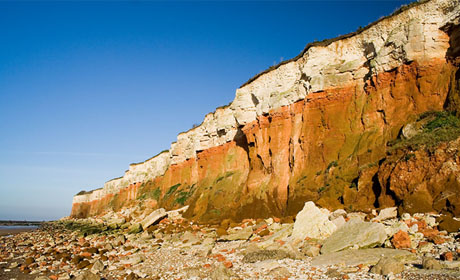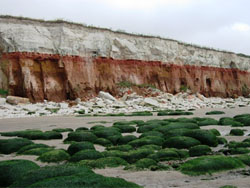Hunstanton Cliffs
Norfolk, England
 The People’s Choice
The People’s Choice
Although Hunstanton is on the east coast of the UK, the shore faces west and you can watch the sun setting over the sea there. From a distance, the cliffs are a striking combination of colours, and as you approach, it becomes evident that the eastward-dipping stratigraphy is more complex than it appears from further away.

The base of the cliffs consists of red-brown carstone – sandstone and pebbly sandstone which contains some feldspar and glauconite. Some of the carstone is cross-stratified. There are very occasional body fossils in this layer but the top of it is bioturbated. The carstone was laid down in shallow marine conditions; during the Cretaceous, Earth was experiencing greenhouse conditions with correspondingly high sea-levels. Where the carstone is exposed on the foreshore, it has a striking jointing pattern.
The famous Hunstanton Red Rock sequence, above the carstone, is well-exposed – this was laid down in deep marine conditions. It can be divided into three beds separated by bands of marl. The Red Rock is actually chalk – the red colour comes from iron pigments. The red chalk is very rich in fossils (including ammonites and belemnites). The top of it, and the base of the overlying white chalk, are bioturbated by shrimp burrows.
The white chalk was also laid down in deep marine conditions. It consists of a series of distinctive beds rather than being a uniform structure.
Hunstanton Cliffs provide important information about then-current conditions.
Text courtesy of Naomi Stevenson, Green Geology